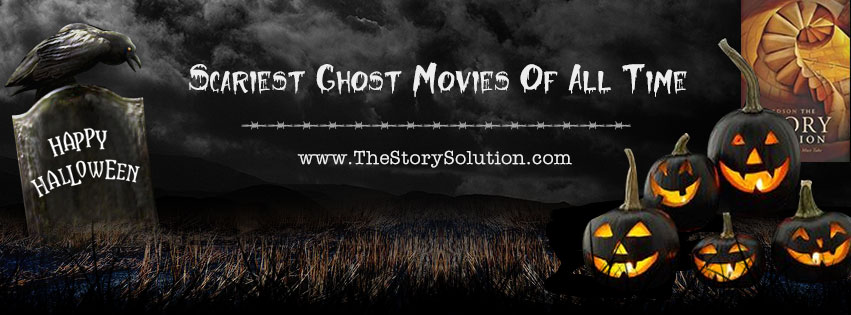Eric Edson Presents: The Scariest Ghost Movies of All Time
At Halloween our thoughts turn to ghosts, goblins, ghouls, and all things frightening. Aspiring screenplay writers know that movie genres vary considerably, but spine-tingling ghost movies are one of the most entertaining areas to explore. If you are writing a movie script about a ghost story, you can take advantage of Halloween’s charged atmosphere to gather inspiration.
Some screenwriters do a masterful job of keeping an audience glued to the edge of their seats. From supernatural scares to haunted house ambience and Hitchcockian twists, here are five of what we consider to be, the scariest ghost movies of all time. Let’s take a look at what makes their screenplays so spookily supreme.
The Others
Written & Directed by Alejandro Amenabar (2001)
It’s England in 1945 and Grace (Nicole Kidman) has moved into a rural mansion with her two light-sensitive children while she waits for her husband to return from fighting in WWII. The appearance of three strange house servants triggers a slow crescendo of supernatural events which leads to an ingenious twist at the climax. The Others is a classic haunted house story but what makes the screenplay so creepily effective is the steady build in suspense, which starts with strange noises and self-closing doors and ends with a terrifying revelation. The screenplay also manages to create an oppressive atmosphere. The weather is permanently foggy and because the children are photosensitive to light, the mansion’s curtains are always drawn and rooms are lit by flickering candles. Screenplay writer, Alejandro Amenábar, turns the idea of the haunted house on its head in a powerfully effective way. Eerie events happen after the mother hires the strange servants. The children sneak out of the house and find the servants’ graves, indicating they died in 1891, and Grace’s terror turns into madness. This film teaches us once again that a strong plot with genuine surprises for the audience is the key ingredient to a screenplay that really works.
What Lies Beneath
Directed by Robert Zemeckis (2000)
Screenplay by Clark Gregg
Story by Sarah Kernochan & Clark Gregg
Norman (Harrison Ford) and his wife Claire (Michelle Pfeiffer) appear to be living a happily married life in their lakeside Vermont home. When Claire starts witnessing creepy phenomena she fears their house is haunted and begins an investigation which ultimately reveals deep, dark secrets hidden beneath the veneer of her perfect marriage. What Lies Beneath is a psychological horror story that pays careful homage to Hitchcock’s genre conventions and motifs, from jarring music to theatrical jumps, shots of mirrors and an intriguing mystery to solve. This screenplay also excels in its thematic use of water and reflections in everything from eerie shots of the lake to the terrifying bathtub scenes. Screenwriter Clark Gregg does a great job in placing Claire believably in a remote Vermont lake house as she recuperates from a serious auto accident. The creepy next door neighbors adds a tasty subplot. Claire comes to believe a ghost is trying to contact her, while her husband thinks it is the after-effects of the accident. The story becomes a hall of mirrors, where the truth is not easily discovered, but comes out in a shocking way at the end. This is an excellent example of using a “Shape Shifter” character to grab the audiences emotions in an unexpected way. Proof once again that to succeed, ghost stories must have shocking reversals in the storyline.
The Ring
Directed by Gore Verbinski (2002)
Screenplay by Ehren Kruger, novel by Kôji Suzuki
The Ring is a Hollywood remake of Hideo Nakata’s frightening Japanese original, a horror-detective story with a truly unforgettable ending. Working from a screenplay by Ehren Kruger, the film is about a journalist (Naomi Watts) investigating the deaths of four teenagers who all died exactly seven days after watching a creepy videotape. After she, her young son and ex-husband watch the tape, they race to discover its true meaning before the phone rings and a voice informs them they have seven days left to live. Their investigation uncovers a husband and wife who adopted a child with the ability to inhabit the minds of people and animals, driving them all insane. The mother is dragged off to a mental hospital where she commits suicide, and the daughter disappears. It is left to journalist Rachel to figure out the true origins of this deadly videotape before it kills her own son. The screenplay effectively sweeps the audience along with the main character on her quest to break the curse before its too late. While the film cleverly plays with ideas about urban legends, at the core it is an exciting supernatural detective story that, like all ghost stories which work, reveals The Ring’s true power to be in its final shocking moments. If you want to write a supernatural thriller, you must pound on your concept until you find that one gem of a twist for the ending.
Poltergeist
Directed by Tobe Hooper (1982)
Screenplay by Steven Spielberg & Michael Grais & Mark Victor
This acclaimed supernatural ghost movie tells the story of a young family that is terrorized by multitude of spirits. The haunting begins when Carol Anne (Heather O’Rourke), the angelic youngest daughter, starts talking to the “TV people” and household objects begin moving around by themselves. When the ghosts turn nasty and Carol Anne vanishes into the spirit realm, things escalate into a thrilling spectacle of special-effects in the finale. The screenplay for Poltergeist works so well because it plants the family firmly in the normality of suburban America and creates very sympathetic characters. The events are all the more horrifying because they occur in the family home that normally signifies safety and comfort. This Steven Spielberg screenplay gave us the classic line, “They’re here!” A parapsychologist acts as a medium and attempts to retrieve the youngster from spirits who are stuck between this world and the light of the next world. After a night of terror, it is discovered that the real estate company who sold the family this house lied about digging up and relocating an entire cemetery full of corpses to make room for their development, and instead just moved the headstones and left the bodies beneath the houses. So the spirits are really ticked off. This story demonstrates a universal truth that at the heart of any plot there must be one, or a few, sympathetic characters. If we didn’t like this family so much, we wouldn’t fear for them, or be rooting for their safety. It takes relatable characters to draw an audience in emotionally.
Dark Water
Directed by Walter Salles
Screenplay by Rafael Yglesias, novel by Kôji Suzuki
Based on a moody and dark screenplay, this movie tells the story of a mother and young daughter who hole up in a creepy, run-down apartment building during a bitter divorce. They discover their “safe haven” is haunted, and has a constant drip of dark water from the bedroom ceiling. Strange events follow; water pours down the walls and a child’s school bag keeps reappearing no matter how many times it’s thrown out. The daughter plays with an imaginary friend, Natasha, but it is discovered that Natasha was also a Russian girl who lived upstairs. Her parents abandoned her, and left the child to die. Dark Water is in many ways a classic haunted house story about a ghost looking for closure. What’s great about the screenplay is that rather than setting the story in a typical creepy house, the action takes place in a run-down yet modern-day apartment block with cramped, damp rooms. This creates a stifling sense of claustrophobia. Dark Water is the second film Hideo Nakata has adapted from a Japanese ghost story. In ghost stories, mood and atmosphere are so important that they can be considered members of the cast.
When you view these films, pay careful attention to how they build suspense and manipulate plot twists. Incorporate the best of the genre’s conventions and motifs but don’t be afraid to put a modern twist in your tale.
Halloween is the perfect time to start writing your next truly terrifying screenplay. If you want to learn more about scary scriptwriting, watch these classic ghost movies, if you dare!
What do you think are the scariest ghost movies of all time? Share your thoughts with us!
Happy Halloween to Everyone!
Eric Edson
About The Story Solution: Eric Edson’s The Story Solution provides screenwriting tips for those interested in screenplay writing. Seen as one of the best books on screenwriting, Edson outlines 23 actions used to create three dimensional heroes. Visit the website at https://www.thestorysolution.com/ to learn about writing a movie script. “Like” the Facebook page to receive tips on scriptwriting. Call (818) 677-7808 for information about writing a movie script.






